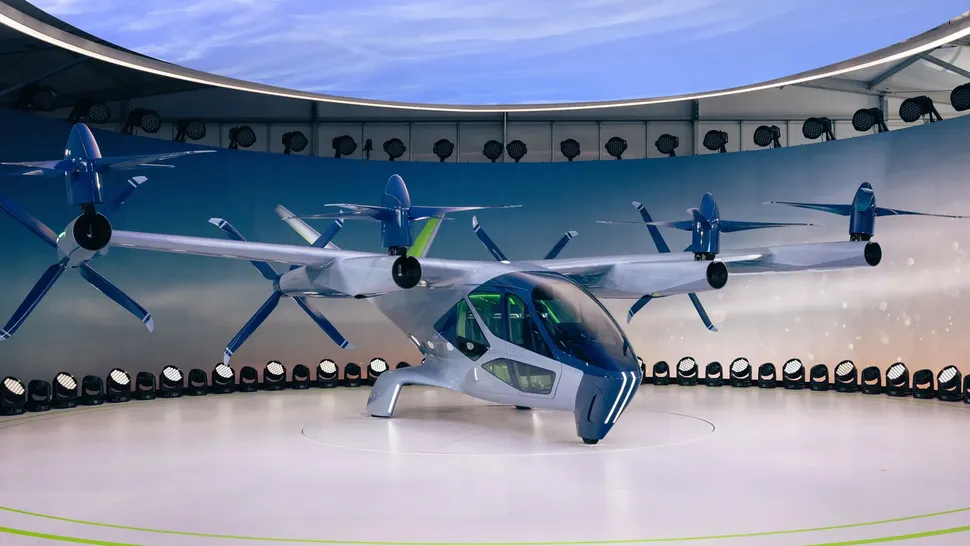Futuristic vertical-takeoff air taxi could fly by 2028
The aircraft can cruise at 120 mph at an altitude of up to 1,500 feet — and it's much quieter than a helicopter.

A proof-of-concept four-passenger air taxi that can take off and land vertically is slated to hit the market by 2028.
Known as an electric vertical takeoff and landing (eVTOL) vehicle, the SA-2 is made by Hyundai subsidiary Supernal and will begin test flights later this year, company representatives announced on Jan. 9 at CES 2024.
Several manufacturers have built working eVTOLs in the last few years, including Boeing's NeXt, Airbus' CityAirbus NextGen and Honda's eVTOL vol.2. These vehicles rely on distributed electric propulsion (DEP) to fly — defined as spreading multiple electric motors and propellers across the airframe, Simay Akar, Institute of Electrical and Electronics Engineers senior member and the CEO and founder of AK Energy Consulting, told Live Science. Similarly, Supernal's air taxi lifts off using eight all-tilting rotors distributed across its body, which produces enough thrust required for flight.
"While it will likely take some time for DEP-powered eVTOLs to become commonplace, they are sure to play a major role in the future of urban air mobility," she said. But several things, including legal frameworks and better technology, will need to be in place before that happens, she added. The SA-2 is designed to cruise at 120 mph (193 km/h) at an altitude of up to 1,500 feet (457 meters) and is to complete trips of between 25 and 40 miles (40 to 64 kilometers).
Related: World’s 1st electric flying passenger ship could 'revolutionize how we travel on water'
The vehicle will emit 65 decibels while taking off and landing, while its midflight sound levels will max out at 45 dB — making it quieter than a helicopter, which makes between 93 dB and 108 dB of noise, according to the Federal Aviation Administration (FAA).
If you're feeling any sense of dé jà vu, it's because Hyundai previously showcased an earlier version of this vehicle in 2020. The company said it planned to start test flights in 2023, according to Future Flight, but those plans didn't take off, as they originally entailed working with Uber, which sold its air taxi division in 2020.
Get the Space.com Newsletter
Breaking space news, the latest updates on rocket launches, skywatching events and more!
Supernal now plans on conducting test flights later this year. The company also plans to file preliminary applications to the FAA this year, before seeking a special airworthiness certificate in 2025. Further testing will begin in 2027.
Hyundai is still targeting a 2028 launch date for the production of its air taxis, but whether this public transport method takes off depends on the legal status of eVTOLs. Akar also told Live Science the widespread adoption of eVTOLs hinges on several technologies including battery energy density, motor and power electronics efficiency, thermal management and weight management.
Legislatures across the world are currently considering the safety and air traffic concerns involved. However, in August 2023, the European Union Aviation Safety Agency released a set of proposed rules for safely operating eVTOLs in Europe — with the industry attempting to launch eVTOL services in time for the 2024 Olympic Games in Paris.
In June 2023, the FAA finalized new rules that would help pave the way for commercial air taxi services in the coming years. These provisions included which qualifications pilots must hold, the operational requirements of the aircraft, the process for receiving type certification, and other areas. In July 2023, the FAA also published its implementation plan for introducing air taxi services across the U.S. — targeting 2028 for when commercial flights will begin, based on its Innovate28 initiative.
Join our Space Forums to keep talking space on the latest missions, night sky and more! And if you have a news tip, correction or comment, let us know at: community@space.com.

Keumars is the technology editor at sister site Live Science. He has written for a variety of publications including ITPro, The Week Digital, ComputerActive and TechRadar Pro. He has worked as a technology journalist for more than five years, having previously held the role of features editor with ITPro.
An NCTJ-qualified journalist who specializes in technology, his path into journalism began at university. He immersed himself in student media while studying for a degree in Biomedical Sciences at Queen Mary, University of London. After graduating, Keumars wrote for a variety of local and national publications as a freelancer, including The Independent, The Observer, and Metro. While studying for his NCTJ certification, his work was commended in the category of ‘Top Scoop’ in the 2017 NCTJ awards. He’s also registered as a foundational chartered manager with the Chartered Management Institute (CMI), having qualified as a Level 3 Team leader with distinction in 2023.
-
SubSailor Not very efficient, only has a flight time of 12.5-20 minutes before it's grounded for a recharge. Hyundai hasn't said how long it takes to recharge the SA-2 batteries.Reply -
Singlebritson Joby Aviation already has a working eVTOL 4-passenger helicopter which they have tested in NYC and in California. They have a contract with the DoD to provide several for on-base transport and have worked with the FAA to develop policies for these electric copters. Overall much more advanced than the proposed copter in the article, quieter and with longer range. See their website for videos and details.Reply










